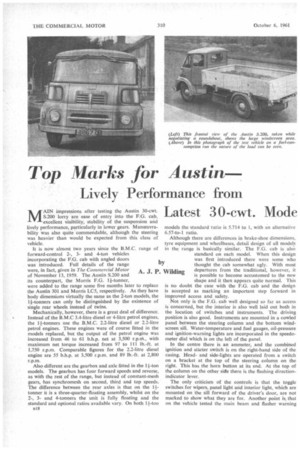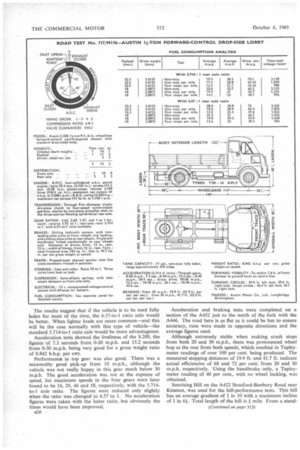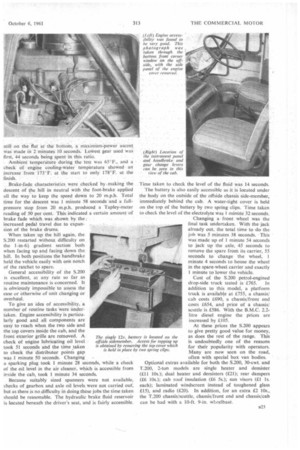Top Marks for Austin
Page 52

Page 53

Page 54

Page 57

If you've noticed an error in this article please click here to report it so we can fix it.
Lively Performance from Latest 30-cwt. Mode
by A. J. P. Wilding
MAIN impressions after testing the Austin 30-cwt. S.200 lorry are ease of entry into the F.G. cab, excellent visibility, stability of the suspension and lively performance, particularly in lower gears. Manceuvrability was also quite commendable, although the steering was heavier than would be expected from this class of vehicle.
It is now almost two years since the B.M.C. range of forward-control 2-, 3and 4-ton vehicles incorporating the F.G. cab with angled doors was introduced. Full details of the range were, in fact, given in The Commercial Motor of November 13, 1959. The Austin S_200 and its counterpart, the Morris F.G. 11-tonner, were added to the range some five months later to replace the Austin 301 and Morris LC5, respectively. As they have body dimensions virtually the same as the 2-ton models, the 14-tonners can only be distinguished by the existence of single rear wheels instead of twins.
Mechanically, however, there is a great deal of difference. Instead of the B.M.0 3.4-litre diesel or 4-litre petrol engines, the 1f-banners use the B.M.C. 2.2-litre diesel or 2.2-litre petrol engines. These engines were of course fitted in the models replaced, but the output of the petrol engine was increased from 46 to 61 b.h.p. net at 3,500 r.p.m., with maximum net torque increased from 97 to I 1 1 lb.-ft. at 1,750 r.p.m. Comparable figures for the 2.2-litre diesel engine are 55 b.h.p. at 3,500 r.p.m. and 89 lb.-ft. at 2,800 r.p.m.
Also different are the gearbox and axle fitted in the 14-ton models. The gearbox has four forward speeds and reverse, as with the rest of the range, but instead of constant-mesh gears, has synchromesh on second, third and top speeds. The difference between the rear axles is that on the lftonner it is a three-quarter-floating assembly, whilst on the 2-, 3and 4-tonners the unit is fully floating and the standard and optional ratios available vary. On both 1f-ton models the standard ratio is 5.714 to 1, with an alternative 6.57-to-1 ratio.
Although there are differences in brake-shoe dimensions, tyre equipment and wheelbases, detail design of all models in the range is basically similar. The F.G. cab is also standard on each model. When this design was first introduced there were some who thought the cab somewhat ugly. With most departures from the traditional, however, it is possible to become accustomed to the new shape and it then appears quite normal. This is no doubt the case with the F.G. cab and the design is accepted as marking an important step forward in improved access and safety.
Not only is the F.G. cab well designed so far as access is concerned, but the interior is also well laid out both in the location of switches and instruments. The driving position is also good. Instruments are mounted in a cowled panel between the steering column and the bottom windscreen sill. Water-temperature and fuel gauges, oil-pressure and ignition-warning lights are incorporated in the speedometer dial which is on the left of the panel.
In the centre there is an ammeter, and the combined ignition and starter switch is on the right-hand side of the casing. Headand side-lights are operated from a switch on a bracket at the top of the steering column on the right. This has the horn button at its end. At the top of the column on the other side there is the flashing directionindicator lever,
The only criticism of the controls is that the toggle switches for wipers, panel light and interior light, which are mounted on the sill forward of the driver's door, are not marked to show what they are for. Another point is1 that on the vehicle tested the main beam and flasher warning
lights, which are located in a housing at the top of the steering column, are hidden by one of the steering-wheel spokes in the straight-ahead position —the flasher light is hardly bright enough to sec in daylight anyway.
In general the S.200 handled very well. After a short time I got used to the steering heaviness and was not troubled by it. In spite of the heaviness the steering in no way feels "dead." Castor action was found to be very good and response and " feel " were excellent. Neither was there any indication of underor over-steer, and after driving the test vehicle for most of the day, I was not unduly tired.
Gear changing was helped by a good synchronizing action on the three higher ratios. It was difficult though to change down from third to second, particularly when the gearbox was cold.
Because there are two rear axle ratios available, it was decided to obtain fuel consumption figures for both. There was not much difference between the two so far as driving was concerned except that the S.200 was naturally a little livelier with the lower, 6.57-to-1 ratio, but the 5.714-to-1 ratio provided quite a good performance, however. Commercial-grade petrol was used throughout the tests, incidentally, with only slight pinking when the engine became fairly hot.
All tests were carried out in the Birmingham area with gravel as the load. Gross vehicle weight was 3 tons 12+ cwt. with 1 ton 10 cwt. over the front wheels and 2 tons 21 cwt. over the rear. When the load had been removed, the unladen weight was found to be 1 ton 161 cwt., which with driver, passenger and equipment weighing about 31 cwt., meant that there was an overload of some 21cwt. For both series of fuel consumption tests the S.200 was run at the same gross vehicle weight so that the tests would be truly comparable. The weight was measured on the same weighbridge.
A three-mile section of the A441 from the roundabout at the junction with the B4120 then north to a gap in the dual-carriageway section beyond Hopwood was used. The out-and-return run measured exactly six miles, but differed from the usual test route on the A6, north of Barton being generally' more hilly. There was one fairly long up-grade which necessitated third gear towards the top when fully laden. With both axle ratios a full series of tests, except for unladen runs, was completed, the oneand four-stops-per-mile being intended to simulate delivery work. The consumption figures obtained are fairly commendable for a petrol-engined vehicle of this capacity.
It is interesting that with the 5.714-to-I ratio axle, consumption was some 1 m.p.g. worse than with the 6.57-to-1 on the full-load runs, but better by about the same amount when part of the load was removed. All the figures are fairly consistent and indicate that the consumption that operators could expect would be around 18-22 m.p.g. depending on conditions. The results suggest that if the vehicle is to be used fully laden for most of the time, the 6.57-to-1 ratio axle would be better. When lighter loads are more common-and this will be the case normally with this type of vehicle-the standard 5.714-to-1 ratio axle would be more advantageous.
Acceleration tests showed the liveliness of the S.200, the figures of 7.3 seconds from 0-20 m.p.h. and 15.2 seconds from 0-30 m.p.h. being very good for a gross weight ratio of 0.842 b.h.p. per cwt.
Performance in top gear was also good. There was a reasonably good pick-up from 10 m.p.h., although the vehicle was not really happy in this gear much below 30 m.p.h. The good acceleration was not at the expense of speed, for maximum speeds in the four gears were later found to be 16, 29, 46 and 58, respectively, with the 5.714to-1 axle ratio. The figures were reduced only slightly when the ratio was changed to 6.57 to 1. No acceleration figures were taken with the latter ratio, but obviously the times would have been improved.
820
Acceleration and braking tests were completed on a section of the A452 just to the north of the fork with the A446. The road here is as flat as it could be but to ensure accuracy, runs were made in opposite directions and the average figures used.
Although extremely stable when making crash stops from both 20 and 30 m.p.h., there was pronounced wheel hop at the rear from both speeds, which resulted in Tapleymeter readings of over 100 per cent, being produced. The measured stopping distances of 19.9 ft. and 41.7 ft. indicate actual efficiencies of 68 and 72 per cent. from 20 and 30 m.p.h. respectively. Using the handbrake only, a Tapleymeter reading of 40 per cent., with no wheel locking, was obtained.
Sunrising Hill on the A422 Stratford-Banbury Road near Kineton, was used for the hill-performance tests. This hill has an average gradient of 1 in 10 with a maximum incline of 1 in 61. Total length of the hill is I mile. From a stand still on the flat at the bottom, a maxirrinmpower ascent was made in 2 minutes 10 seconds. Lowest gear used was first, 44 seconds being spent in this ratio.
Ambient tempetattire during the test was 65°F., and a check of engine cooling-water temperature showed an increase from 173°F, at the start to only 178°F. at the finish.
Brake-fade characteristics were checked by making the descent of the hill in neutral with the foot-brake applied all the way to keep the speed down to 20 m.p.h. Total time for the descent was 1 minute 58 seconds-and a fullpressure stop from 20 m.p.h. produced a Tapley-meter reading of 50 per cent. This indicated a certain amount of brake fade which was shown by the ;
increased pedal travel due to expansion of the brake drums.
When taken up the hill again, the S.200 restarted without difficulty on the 1-in-6÷ gradient section both when facing up and facing down the hill. In both positions the .handbrake held the vehicle easily with one notch of the ratchet to spare.
General accessibility of the S.200 is excellent, at any rate so far as routine maintenance is concerned. It is obviously impossible to assess the ease or otherwise of unit changing or overhaul.
To give an idea of accessibility, a number of routine tasks were undertaken. Engine accessibility is particularly good and all components are easy to reach when the two side and the top covers inside the cab, and the front exterior grille are removed. A check of engine lubricating oil level took 51 seconds and the time _taken to check the 'distributor points gap was 1 minute 50 seconds. Changing
a, sparking plug took 1 minute 28 seconds, while a check of the oil level in the air cleaner, which is accessible from inside the cab, took 1 minute 34 seconds.
Because suitably sized spanners were not available, checks of gearbox and axle oil levels were not carried ouf, but as there is no difficulty in doing these jobs the time taken should be reasonable. The hydraulic brake fluid reservoir is located beneath the driver's seat, and is fairly accessible. Time taken to check the level of the fluid was 14 seconds.
The battery is also easily accessible as it is located under the body on the outside of the offside chassis side-member, immediately behind the cab. A water-tight cover is held on the top of the battery by two spring clips. Time taken to check the level of the electrolyte was 1 minute 32 seconds.
Changing a front wheel was the final task undertaken. With the jack already out, the total time to do the job was 5 minutes 38 seconds. This was made up of 1 minute 54 seconds to jack up the axle, 45 seconds to remove the spare from its carrier, 55 seconds to change the wheel, 1 minute 4 seconds to house the wheel in the spare-wheel carrier and exactly 1 minute to lower the vehicle.
Cost of the S.200 petrol-engined drop-side truck tested is £765. In addition to this model, a platform truck is available at £755, a chassis/ cab costs £690, a chassis/front end costs £654, and price of a chassis/ scuttle is £586. With the B.M.C. 2.2litre diesel engine the Prices are increased by £105.
At these prices the S.200 appears to give pretty good value for money, as does the rest of the range. This is undoubtedly one of the reasons for their popularity with operators. Many are now seen on the road, often with special box van bodies.
Optional extras available for both the S.200, 30-cwt. and T.200, 2-ton models are single heater and demister ail 10s.); dual heater and demisters (£21); rear dampers (£6 10s.); cab roof insulation (£6 5s.); sun visors (£1 Is. each); laminated windscreen instead of toughened glass £15), and radio (m). In addition, for an extra £2 10s., the T.200 chassis/scuttle, chassis/front end and chassis/cab can be had with a 10-ft. 9-in. wlwelbase.




























































































































































